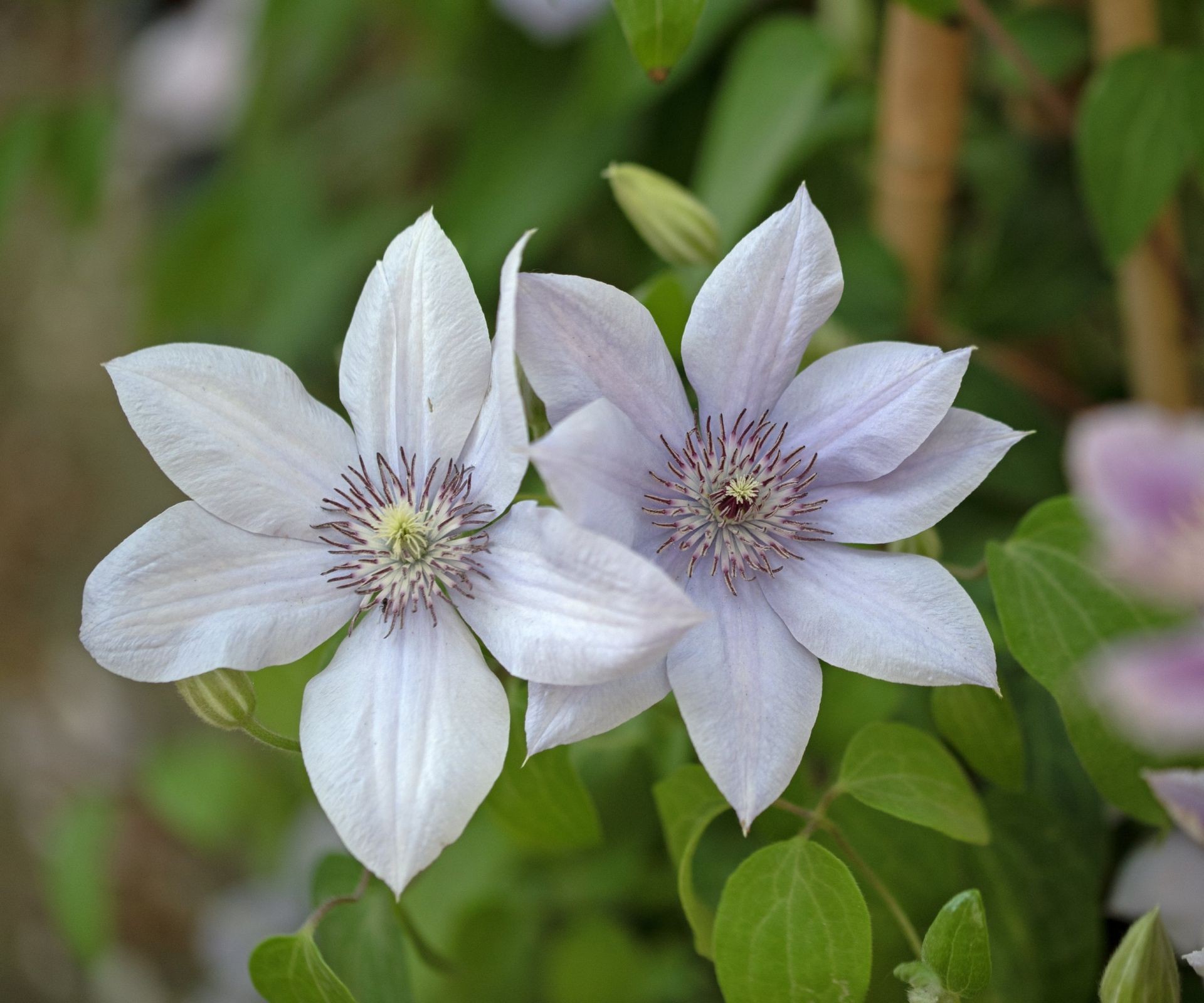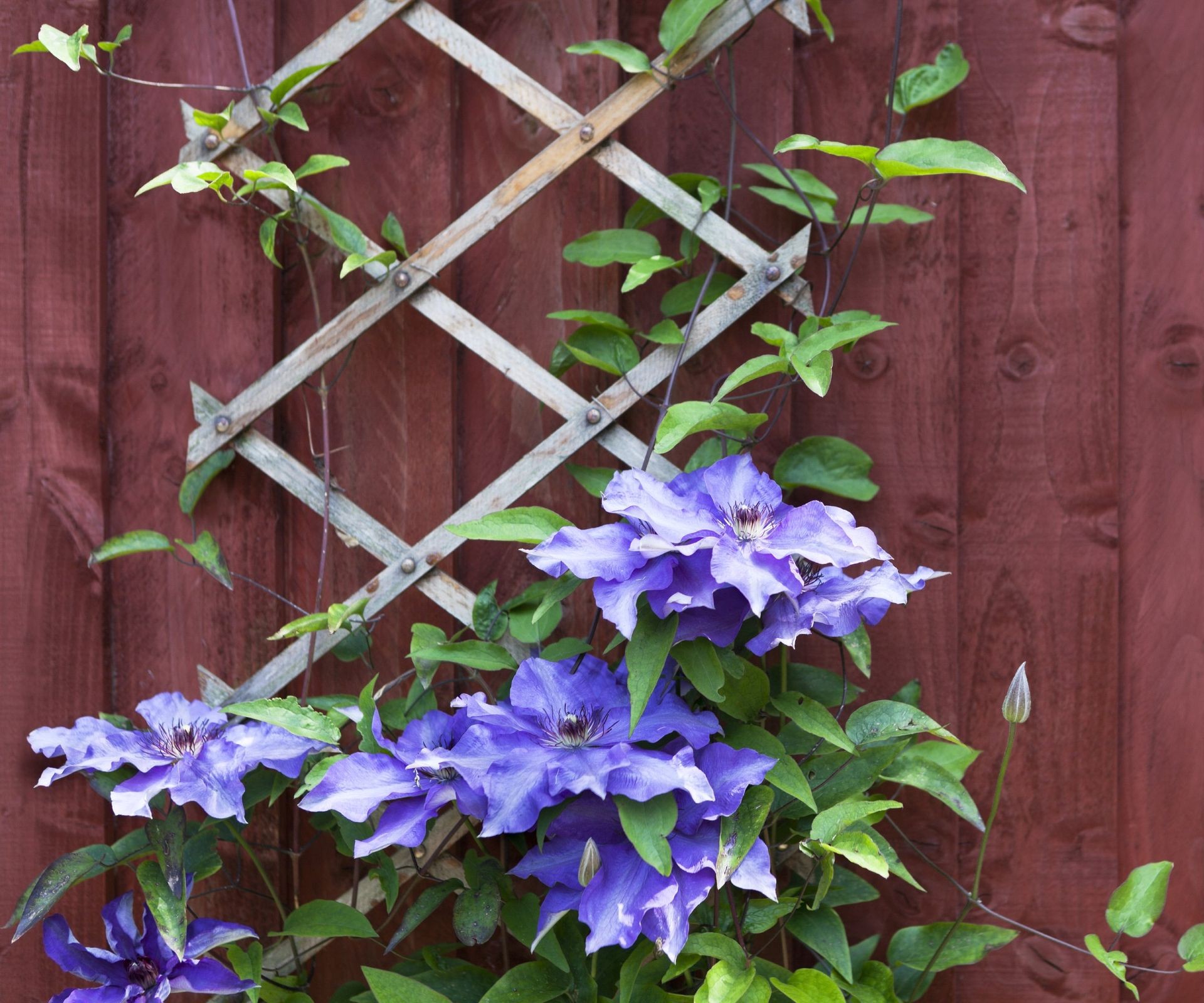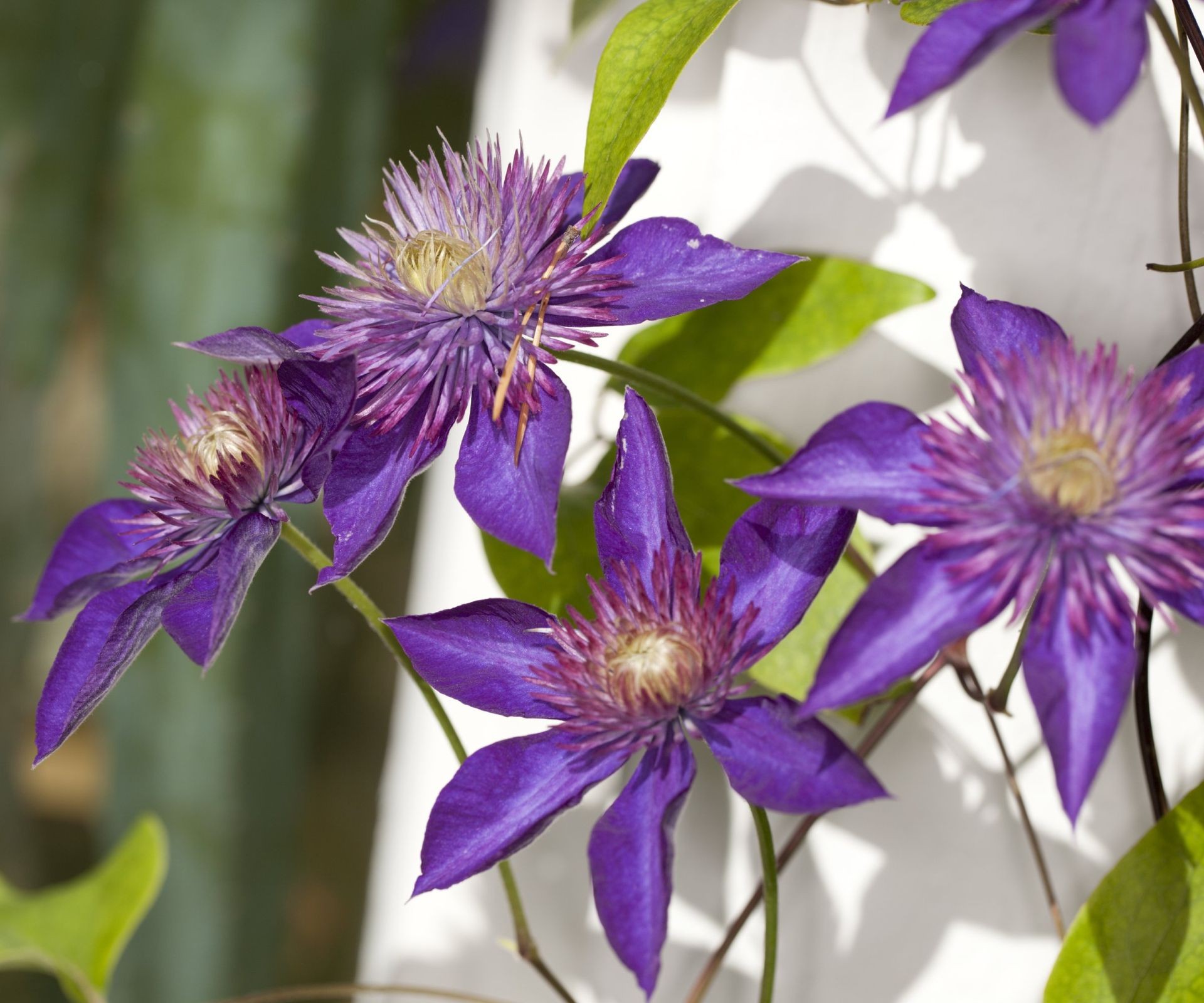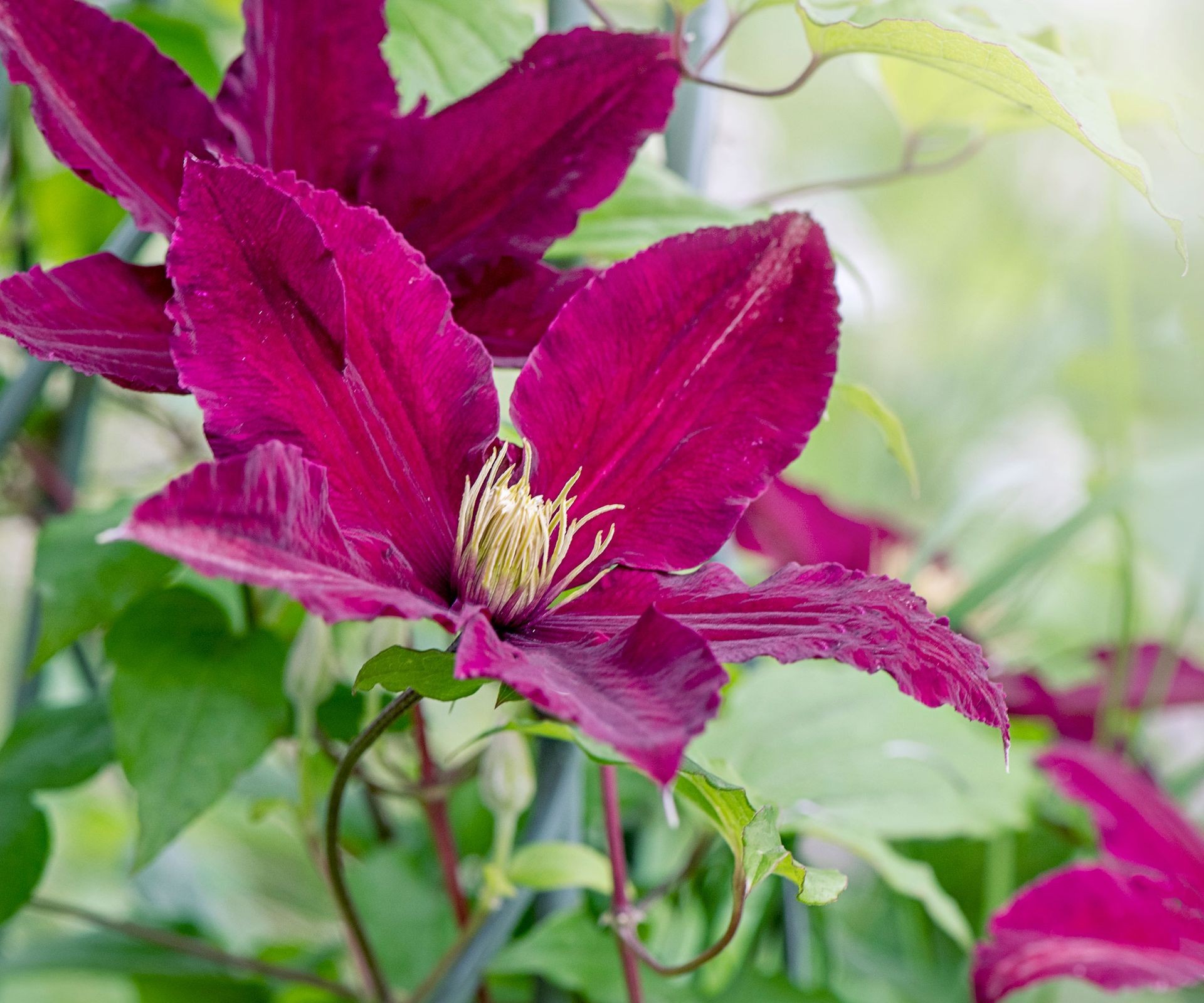Taking care of a clematis involves understanding its specific needs to ensure vibrant blooms and healthy growth. At CARS.EDU.VN, we believe that like cars, plants also need regular care to function at their best. This guide dives into how to care for clematis, covering everything from planting to pruning, to help you cultivate thriving climbing flowers, flowering vines, and more.
1. Understanding Clematis Varieties and Their Needs
Clematis, belonging to the Clematis spp. genus, is celebrated for its diverse range of species, each presenting unique flowering forms, colors, and blooming seasons. Understanding these differences is crucial for successful clematis care. There are approximately 300 species. Recognizing these differences is the first step in providing the best possible care. According to the American Clematis Society, choosing the right variety is key to a thriving garden.
1.1. Key Factors Influencing Clematis Health
| Factor | Description |
|---|---|
| Sunlight | Most clematis varieties thrive with at least six hours of direct sunlight daily, but some prefer partial shade in hotter climates. |
| Watering | Consistent moisture is vital, especially during the establishment phase. Established plants need about 1 inch (2.5 cm) of water weekly. |
| Soil | Well-drained soil, slightly acidic to neutral (pH 6.5-7.0), is ideal. |
| Fertilizer | A balanced fertilizer at planting and annually in early spring supports healthy growth. |
| Support | Trellises, arbors, or fences provide necessary support for climbing. |
| Pruning | Varies greatly depending on the group; understanding your clematis’s pruning needs is essential. |




1.2. Choosing the Right Clematis Variety
Selecting the right clematis variety is paramount for successful gardening. Consider these factors:
- Blooming Season: Do you want spring, summer, or fall blooms?
- Flower Color and Size: Clematis offers a wide range of colors and flower sizes.
- Mature Size: Ensure the variety fits your available space and support structure.
2. Planting Clematis for Success
Proper planting sets the stage for a healthy and vibrant clematis.
2.1. Selecting the Planting Location
Clematis thrives when its “head is in the sun and feet in the shade.” This means:
- Sunlight: At least six hours of direct sunlight daily.
- Shade: Protection for the roots from direct sun.
2.2. Preparing the Soil
- Drainage: Ensure the soil is well-draining to prevent root rot.
- Soil Amendment: Mix in compost to enrich the soil and improve drainage.
2.3. Planting Steps
- Dig a Hole: Make the hole twice as wide and deep as the root ball.
- Amend the Soil: Mix compost with the excavated soil.
- Plant the Clematis: Position the plant so the top of the root ball is level with the ground.
- Backfill: Fill the hole with the amended soil, gently tamping down.
- Water Thoroughly: Water deeply to settle the soil.
- Mulch: Apply a layer of mulch around the base to retain moisture and keep the roots cool.
2.4. Providing Support
Clematis vines require a support structure to climb. Options include:
- Trellises: Ideal for most clematis varieties.
- Arbors: Suitable for larger, more vigorous types.
- Fences: A simple and effective option.
- Poles: Acceptable for smaller growing clematis vines.
3. Watering and Feeding Your Clematis
Consistent watering and proper fertilization are key to healthy growth and abundant blooms.
3.1. Watering Schedule
- New Plants: Water deeply and regularly to establish a strong root system.
- Established Plants: Provide at least 1 inch (2.5 cm) of water per week.
- Dry Spells: Increase watering frequency during dry periods.
3.2. Fertilizing Clematis
- At Planting: Apply a balanced fertilizer to promote root development.
- Annually: Fertilize in early spring before new growth begins.
- Type of Fertilizer: Use a balanced fertilizer or one formulated for flowering plants.
4. Pruning Clematis: A Detailed Guide
Pruning is essential for maintaining the health and bloom production of clematis, but it varies significantly depending on the type.
4.1. Understanding Pruning Groups
Clematis are typically categorized into three pruning groups:
- Group 1: Early-flowering varieties that bloom on old wood (previous year’s growth).
- Group 2: Large-flowered varieties that bloom on both old and new wood.
- Group 3: Late-flowering varieties that bloom on new wood (current year’s growth).
4.2. Pruning Group 1 Clematis
- When to Prune: Immediately after flowering in late spring or early summer.
- How to Prune: Lightly prune to remove dead or overcrowded stems. Avoid heavy pruning, as this will reduce the following year’s blooms.
4.3. Pruning Group 2 Clematis
- When to Prune: Late winter or early spring.
- How to Prune: Remove any dead or damaged stems. Lightly trim to shape the plant, but avoid cutting back too hard. After the first flush of flowers, you can deadhead (remove spent blooms) to encourage a second bloom.
4.4. Pruning Group 3 Clematis
- When to Prune: Late winter or early spring.
- How to Prune: Cut back all stems to about 12 inches (30 cm) from the ground. This encourages vigorous new growth and abundant blooms.
Pruning Groups Overview
| Group | Blooming Time | Blooms On | Pruning Time | Pruning Instructions |
|---|---|---|---|---|
| 1 | Early Spring | Old Wood | After Flowering | Lightly prune dead or overcrowded stems |
| 2 | Late Spring/Early Summer | Old and New Wood | Late Winter/Early Spring | Remove dead/damaged stems, lightly trim |
| 3 | Summer/Fall | New Wood | Late Winter/Early Spring | Cut back all stems to 12 inches |
4.5. General Pruning Tips
- Use Sharp Tools: Clean, sharp pruning shears or loppers are essential.
- Make Clean Cuts: Cut at a 45-degree angle just above a node (where a leaf or bud grows).
- Remove Dead or Diseased Wood: Always remove any dead, damaged, or diseased stems.
- Thin Out Overcrowded Stems: This improves air circulation and reduces the risk of disease.
5. Common Clematis Problems and Solutions
Clematis can be susceptible to certain problems, but with proper care, most can be prevented or treated.
5.1. Clematis Wilt
- Symptoms: Sudden wilting and blackening of foliage and stems.
- Cause: A fungal disease that attacks the stems and vascular system.
- Prevention: Ensure good air circulation, avoid overcrowding, and water at the base of the plant.
- Treatment: Remove and destroy affected stems immediately. In severe cases, you may need to remove the entire plant.
5.2. Powdery Mildew
- Symptoms: White, powdery coating on leaves and stems.
- Cause: A fungal disease that thrives in humid conditions with poor air circulation.
- Prevention: Ensure good air circulation, avoid overcrowding, and water at the base of the plant.
- Treatment: Apply a fungicide specifically designed for powdery mildew.
5.3. Aphids and Spider Mites
- Symptoms: Small insects on leaves and stems, causing discoloration and distorted growth.
- Cause: Pest infestations.
- Prevention: Regularly inspect plants for pests.
- Treatment: Spray with insecticidal soap or neem oil.
5.4. Slugs and Snails
- Symptoms: Holes in leaves, especially on young plants.
- Cause: Slugs and snails feeding on foliage.
- Prevention: Remove debris around the base of the plant.
- Treatment: Use slug and snail bait or handpick them off the plants.
5.5. Root Rot
- Symptoms: Yellowing leaves, stunted growth, and mushy roots.
- Cause: Overwatering or poorly draining soil.
- Prevention: Ensure well-draining soil and avoid overwatering.
- Treatment: Improve drainage and reduce watering frequency. In severe cases, you may need to replant the clematis in a better-draining location.
Troubleshooting Clematis Problems
| Problem | Symptoms | Prevention | Treatment |
|---|---|---|---|
| Clematis Wilt | Sudden wilting, blackening foliage | Good air circulation, avoid overcrowding, water at base | Remove affected stems, consider fungicide |
| Powdery Mildew | White powdery coating | Good air circulation, avoid overcrowding, water at base | Fungicide |
| Aphids/Spider Mites | Small insects, discoloration, distorted growth | Regular inspection | Insecticidal soap, neem oil |
| Slugs/Snails | Holes in leaves | Remove debris | Slug bait, handpick |
| Root Rot | Yellowing leaves, stunted growth, mushy roots | Well-draining soil, avoid overwatering | Improve drainage, reduce watering |
6. Propagating Clematis
Propagating clematis allows you to expand your collection or share these beautiful vines with friends.
6.1. Stem Cuttings
- Take Cuttings: In late spring or early summer, take 4-6 inch (10-15 cm) stem cuttings from new growth.
- Prepare Cuttings: Remove the lower leaves, leaving only a few at the top.
- Rooting Hormone: Dip the cut end in rooting hormone.
- Planting: Plant the cuttings in a well-draining potting mix.
- Humidity: Cover with a plastic bag or dome to maintain humidity.
- Location: Place in a warm, bright location, but out of direct sunlight.
- Watering: Keep the soil consistently moist.
- Rooting: Roots should develop in 4-8 weeks.
- Transplanting: Once rooted, transplant the cuttings into individual pots.
6.2. Layering
- Select a Stem: Choose a low-growing stem that can be easily bent to the ground.
- Prepare the Stem: Make a small cut or scrape on the underside of the stem where it will touch the soil.
- Bury the Stem: Bury the wounded portion of the stem in the soil, securing it with a rock or garden staple.
- Watering: Keep the soil consistently moist.
- Rooting: Roots should develop in several weeks.
- Separation: Once rooted, cut the stem from the parent plant and transplant the new clematis.
7. Popular Clematis Varieties
There are many stunning clematis varieties to choose from, each offering unique colors, sizes, and blooming times.
- “Nelly Moser” Clematis: Known for its large, pink flowers with dark pink stripes.
- “Jackmanii” Clematis: A classic variety with deep purple flowers.
- “Comtesse de Bouchaud” Clematis: A vigorous variety with pink flowers that bloom from midsummer to fall.
- “Henryi” Clematis: A white-flowered variety that is perfect for adding brightness to the garden.
- “Sweet Autumn” Clematis: A late-blooming variety with fragrant white flowers.
| Variety | Flower Color | Bloom Time | Size | Pruning Group |
|---|---|---|---|---|
| Nelly Moser | Pink with Stripes | Late Spring/Early Summer | 6-8 feet | 2 |
| Jackmanii | Deep Purple | Summer | 10-12 feet | 3 |
| Comtesse de Bouchaud | Pink | Midsummer to Fall | 6-8 feet | 3 |
| Henryi | White | Summer | 6-10 feet | 2 |
| Sweet Autumn | White | Late Summer/Fall | 10-20 feet | 3 |
| “Boulevard” Series Clematis | Various | Various | Compact | 2 or 3 |
| “Duchess of Edinburgh” Clematis | Double White | Late Spring/Early Summer | 6-8 feet | 2 |
| “Kilian Donahue” Clematis | Reddish-Pink | Summer | 6-8 feet | 3 |
8. Clematis Care Tips for Specific Climates
Clematis can be grown in a wide range of climates, but certain considerations are necessary for optimal growth.
8.1. Cold Climates (USDA Zones 4-6)
- Winter Protection: Mulch heavily around the base of the plant to protect the roots from freezing temperatures.
- Pruning: Prune Group 3 clematis in late winter or early spring. For Group 2, prune lightly after the first flush of blooms.
- Variety Selection: Choose cold-hardy varieties such as “Jackmanii” or “Comtesse de Bouchaud.”
8.2. Warm Climates (USDA Zones 7-9)
- Afternoon Shade: Provide afternoon shade to protect the plants from intense heat.
- Watering: Water deeply and regularly, especially during hot, dry periods.
- Mulching: Apply a thick layer of mulch to keep the roots cool and moist.
- Variety Selection: Choose heat-tolerant varieties such as “Henryi” or “Sweet Autumn.”
9. Maximizing Clematis Blooms
To ensure abundant and long-lasting blooms, consider these tips:
9.1. Sunlight
Ensure your clematis receives at least six hours of direct sunlight daily.
9.2. Soil
Plant in well-draining soil that is rich in organic matter.
9.3. Watering
Water deeply and regularly, especially during dry periods.
9.4. Fertilizing
Fertilize in early spring with a balanced fertilizer or one formulated for flowering plants.
9.5. Pruning
Prune according to the specific needs of your clematis variety.
9.6. Support
Provide a sturdy support structure for the vines to climb.
9.7. Deadheading
Remove spent blooms to encourage repeat flowering.
10. Integrating Clematis into Your Landscape
Clematis can be used in a variety of ways to add beauty and interest to your landscape.
10.1. Climbing on Structures
Train clematis to climb on trellises, arbors, fences, or pergolas.
10.2. Growing Through Shrubs and Trees
Allow clematis to grow through shrubs and trees for a natural and informal look.
10.3. Container Gardening
Grow clematis in containers on patios, decks, or balconies.
10.4. Ground Cover
Some clematis varieties can be used as ground cover.
FAQ: Taking Care of Clematis
Q1: How much sun does clematis need?
Clematis needs at least six hours of direct sunlight per day to thrive and produce abundant blooms. Some varieties may benefit from afternoon shade in hotter climates.
Q2: What kind of soil is best for clematis?
Clematis prefers well-drained soil that is slightly acidic to neutral (pH 6.5-7.0). Amending the soil with compost can improve drainage and fertility.
Q3: How often should I water my clematis?
Water deeply and regularly, providing at least 1 inch (2.5 cm) of water per week. Increase watering frequency during dry periods.
Q4: When should I fertilize my clematis?
Fertilize in early spring with a balanced fertilizer or one formulated for flowering plants.
Q5: How do I prune my clematis?
Pruning depends on the clematis variety. Group 1 blooms on old wood and should be pruned lightly after flowering. Group 2 blooms on both old and new wood and should be pruned lightly in late winter or early spring. Group 3 blooms on new wood and should be cut back hard in late winter or early spring.
Q6: What is clematis wilt?
Clematis wilt is a fungal disease that causes sudden wilting and blackening of foliage and stems. Remove affected stems immediately and ensure good air circulation.
Q7: How can I protect my clematis from pests?
Regularly inspect plants for pests such as aphids and spider mites. Treat infestations with insecticidal soap or neem oil.
Q8: Can I grow clematis in a container?
Yes, clematis can be grown in containers. Choose a large container with good drainage and use a well-draining potting mix.
Q9: How do I propagate clematis?
Clematis can be propagated by stem cuttings or layering.
Q10: What are some popular clematis varieties?
Popular varieties include “Nelly Moser,” “Jackmanii,” “Comtesse de Bouchaud,” “Henryi,” and “Sweet Autumn.”
Caring for clematis can be a rewarding experience, bringing beauty and elegance to your garden. By understanding the specific needs of your clematis variety and following these tips, you can ensure healthy growth and abundant blooms. Remember, at CARS.EDU.VN, we’re dedicated to providing you with valuable information, just as we are with cars and their maintenance.
Are you finding it challenging to keep your clematis thriving? Or perhaps you’re overwhelmed by the variety of pruning techniques? At CARS.EDU.VN, we understand the importance of reliable information and expert guidance. Just as we provide comprehensive resources for car care, we’re here to help you navigate the world of gardening.
For more in-depth guides, personalized advice, and a wealth of horticultural knowledge, visit CARS.EDU.VN today. Let us help you cultivate the garden of your dreams We are located at 456 Auto Drive, Anytown, CA 90210, United States. Contact us via Whatsapp: +1 555-123-4567. Visit our website: cars.edu.vn